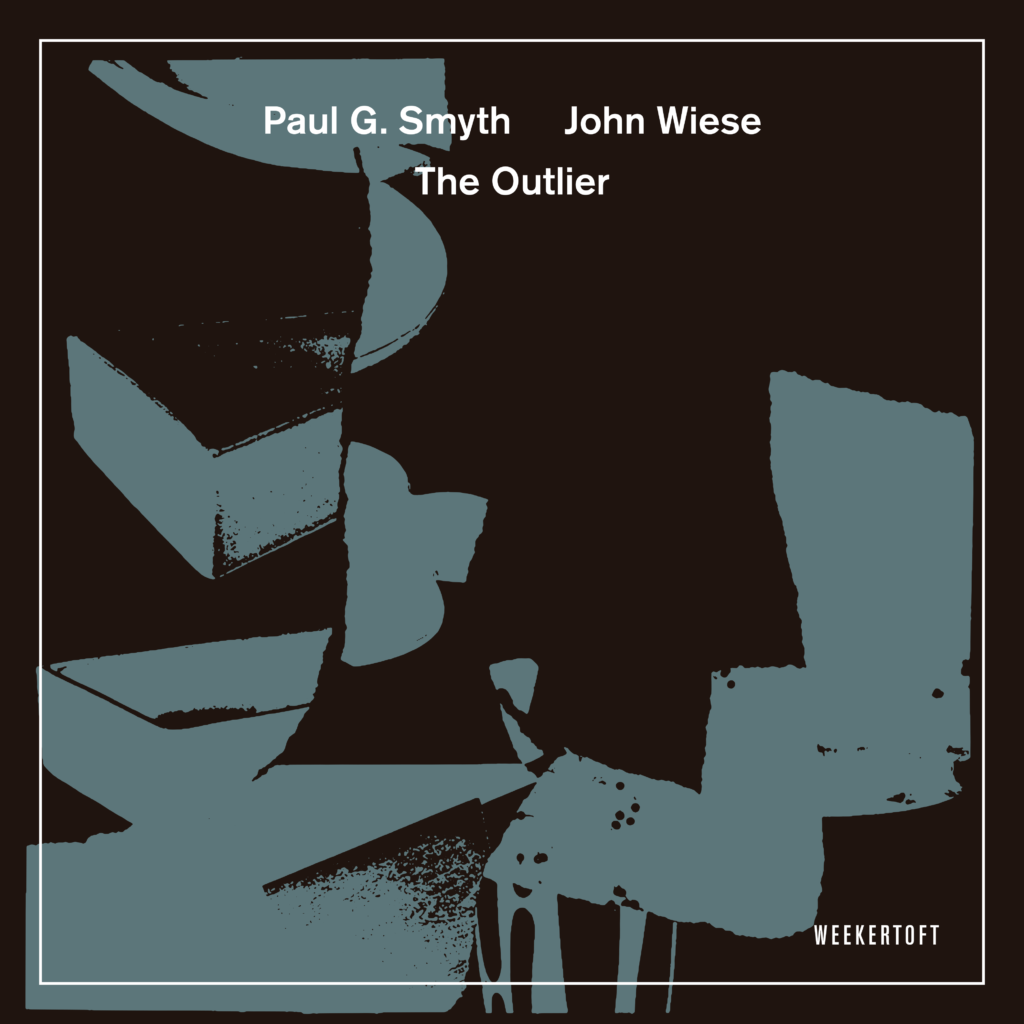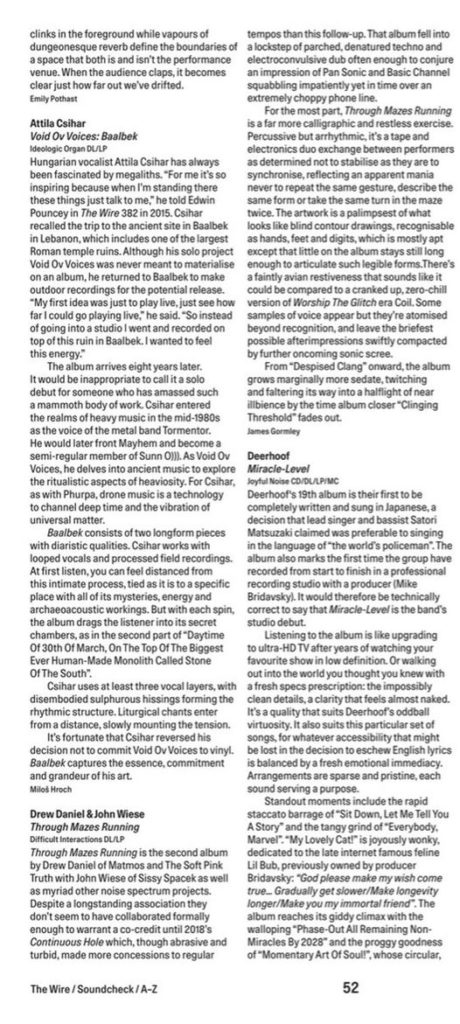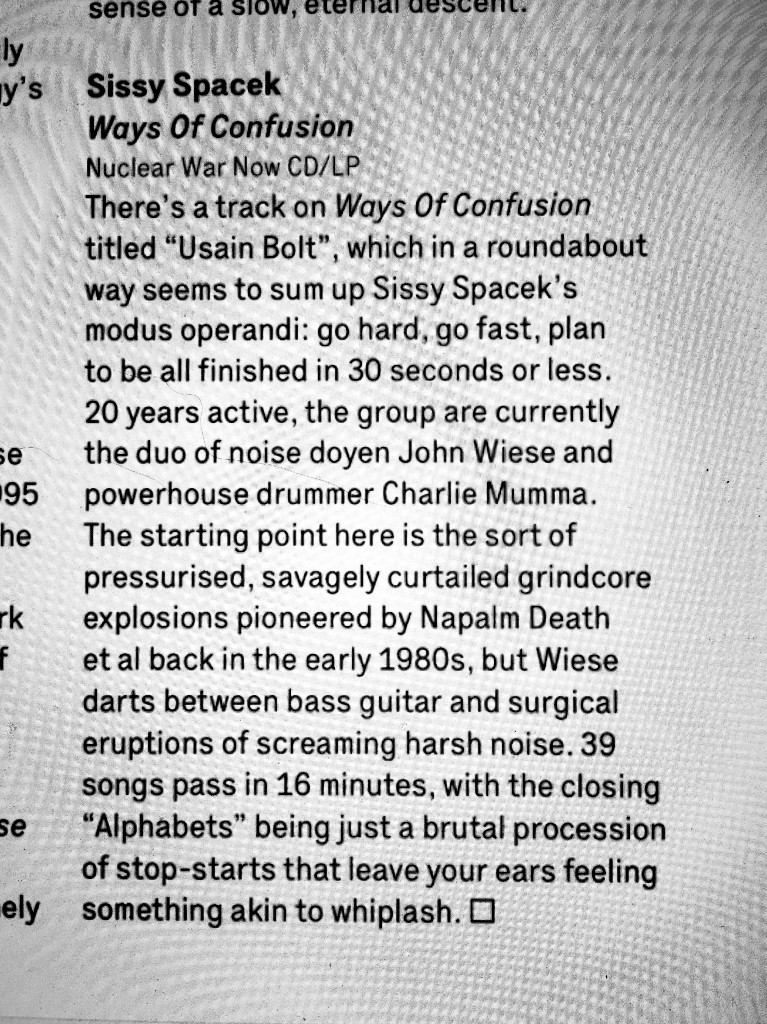Tag Archives: Review

Paul G. Smyth & John Wiese! The Outlier!
Label Weekertoft Records, founded by Irish pianist Paul G. Smyth and English guitarist John Russell, is back after an almost two-year hiatus. The pandemic is a pandemic, but the reason for the inactivity could also be the departure of the guitarist from this part of the universe – we said goodbye to the legend of free impro in January last year.
Despite these still sad circumstances, the fact that the label returns to the world of the living pleases us immensely, especially since its new editorial proposal is simply an excellent album. The prepared piano and a large portion of electronics could raise some concerns at the start, as is usually the case with improvisation that combines live and synthetic phrases, but in the case of The Outlier we can only talk about the successful artistic choices of both musicians. What’s more, the recording is live, so we presume that what we hear on the album is a faithful reflection of what the artists did on stage. All the more respect! And one more important observation at the beginning – Smyth and Wiese during the almost hour-long narration very effectively evoke memories of the minimalist improvisations of the legendary AMM formation! Anyway, they do it many times, even referring to a few aesthetics that this wonderful group introduced into the history of the genre. When the reviewer’s imagination made specific associations, you will find out by reading the entire review. Welcome!
The beginning of the concert is created by a blur of ambient suspended in the vastness of a large concert hall and the filigree clatter of piano hammers, which also seem to create their own ambient. Percussion accents flow from the living flank, and from the synthetic one – the darkness of post-acoustic, mysterious phrases. The narrative has an exceptionally wide electroacoustic spectrum, and the balance between the components seems almost model. Each of these elements is capable of surprising here, and a large part of the sounds cannot be easily attributed to their place of origin. Piano preparations have a lot of question marks, and post-industrial electronics seems to have unlimited possibilities in this regard.
The improvisation sparkles with good interactions, is rich in sounds and dramatic ideas. The musicians do not pursue many heights, do not look for reasons to escalate, and often return for pure ambient and balanced, pianistic deliberations. They consistently build the atmosphere of sensual electroacoustics, which takes its time to look for answers to the questions asked. Sometimes all the streams of narrative cover a post-percussion figure, other times they stick to delicate drones, which reminds us of the aforementioned AMM from the 1980s, when the group consisted of a trio of very actively prepared guitar, piano and percussion. The above association works well, for example, when the piano on the key is subtly dissonant with the noise of electroacoustics. It gets even more beautiful when this minimalist phrasing approaches the area of silence. Acoustics temporarily takes control of synthetics and invites us into the darkness of non-obvious sounds. Almost the entire middle phase of the concert is woven of these dark details and dramatic understatements. Focus, minimalism, flaccid streams of resonance, but also a gigantic anxiety between sounds. After all, these are also features that are inextricably linked with the aesthetics of the formation that we have just mentioned. By the way, at some point in the concert you can get the impression that electronics can also deconstruct piano phrases in the live processing formula.
The next stage of the narrative is a kind of density. The electronics are looking for more noise and post-industrial connotations, while the black piano keys are starting to build really impressive suspense. Darkness, dirty sound and a certain tendency to build slightly more aggressive phrases lead us to another association with AMM, this time with the era when the idiom of free improvisation was forged in bronze and lead in the United Kingdom, i.e. still in the 1960s.
After three quarters of an hour, the musicians slowly begin to close ranks and build the foundations for the end of the performance. Again, we have the impression that we are dealing with live processing – we definitely hear more than one thread of foam. The electronic website also offers us several audio streams. Preparations, electronic distortions, and hundreds of other events take hold of the scene, but the story itself is by no means too far from silence. It is from these details and quarter phrases that the musicians begin to build a denser narrative. Lots of layered post-ambient, but also streams of acoustic preparations, again equipped with the darkness of anxiety and nervous, stealthy glances. The finalization itself seems to be filled with a fleeting hustle and bustle. Black keys, a post-industrial aftertaste of electronics and a lot of chaotic echo in the background. And finally… applause, a sharp return to the reality of the concert and the open space of music.
Paul G. Smyth & John Wiese The Outlier (Weekertoft Records, CD 2022). Paul G. Smyth – piano, John Wiese – electronics. The concert was recorded on February 26, 2015 in Dublin, Kevin Barry Room, National Concert Hall. One improvisation, 53:46
Polar Visions Amplitude reviewing —
Sissy Spacek – Featureless Thermal Equilibrium
Released on September 4, 2020 by Helicopter
Reviewed format: CD album
Connected listening – there are various ways to order a selection of Sissy Spacek’s further discography. The Helicopter mail-order stocks various Sissy Spacek releases and solo works by John Wiese and associates, you can find it here: https://helicopter.storenvy.com/collections/924915-sissy-spacek
Sissy Spacek’s releases on both physical and digital format are also available from their Bandcamp page here: https://sissyspacek.bandcamp.com/music
For an overview of Charlie Mumma’s solo releases as well as the releases he’s featured on as part of various bands, you can check out Discogs here: https://www.discogs.com/artist/1491175-Charlie-Mumma
In a similar manner, Jay Randall’s solo and band releases can be found on Discogs here: https://www.discogs.com/artist/393304-Jay-Randall
Several solo releases by John Wiese are available on physical and digital format from his Bandcamp page here: https://johnwiese.bandcamp.com
As I mentioned in the previous Polar Visions Amplitude review on this blog, 2020 has proven to be quite a fruitful year for both new Noise releases as well as reissues of classic Harsh Noise albums, mentioning the recent Helicopter / Troniks batch of CD releases and today we’re going to start diving into these with a review of one of the most recent Sissy Spacek albums, Featureless Thermal Equilibrium. Sissy Spacek is a John Wiese formed band which as being one of his most well-known projects not only carries a very prolific discography of a big number of albums, EPs, singles and many miscellaneous releases but is also an ever-changing line-up of extreme music artists and performers from various directions of experimental and contemporary music. This makes Sissy Spacek a rather versatile band with the kind of music / Noise you’re going to get on every release being quite unpredictable at times as this could vary from monolithic Harsh Noise to gritty Noise filled Grindcore to free-wheeling electro-acoustic cut-ups of instrumental and vocal recordings created by John Wiese. On Featureless Thermal Equilibrium we get to listen to Sissy Spacek as a raw power filled anarchist Grindcore unit which is continually blasted through with screechy Noise courtesy of John. Sissy Spacek’s core of John Wiese’s streams of Noise (and vocals in this case too) and Charlie Mumma’s fiery thunderous drums and vocals is strengthened here with Jay Randall (of Agoraphobic Nosebleed and various other terror-filled extreme Grindcore and Harsh Noise themed projects) providing particularly aggressive and appropriately screechy screamed vocals to the general energy-filled chaos that is this 24-minute new album. The album is one hell of a ride of dissonant murky noisy sonic energy that blends John Wiese’s screechy layers of Noise with surprisingly crisp sounding vocals and drums which in the case of this album still have quite a dynamic and roomy sound to them, creating some kind of balance in what in other cases could end up being more of a wall of Noise with all elements blending into eachother. Before we dive into this speedy album, it’s good to mention the neat looking presentation of Featureless Thermal Equilibrium, designed by John Wiese. The CD version of the album comes in a sturdy thick 6 panel digipak featuring some great minimalist artwork. The cover artwork is quite striking with its eerie grainy image of a face (which looks familiar but I can’t quite place where I saw it before) with the name of the band and album title set in some quite classy looking serif type. It has quite the classic LP sleeve look to it which purely based on the cover could suggest that the music contained within would be more like Hard Rock or Metal but its grittiness does express the actual music rather well. Other than the cover artwork the imagery on the digipak and CD face feature mostly grainy undefined composed textures that do very well carry that visualised Noise look that best expresses the crumbling shapes of texture that Noise can often conjure up in your mind when you dive into it and start to notice its many subtle variations. John Wiese’s signature type-writer style typography is looking great on the album’s digipak as always with the spine featuring the more recognisable all-caps Sissy Spacek “logo” with wide spacing and while the extra dirt John applies to the letters to make them look more degraded (again matching the music) can make some text a bit harder to read, especially in the credits listed on the back of the digipak, the design looks excellent and adds to the experience of the album’s raw power in visual form. Besides the artwork itself looking great, I also want to point out that the artwork is also printed in very cool looking silvery metallic ink making all art reflect and shine in a subtle manner, giving it some premium edge and the attention to detail that I appreciate a lot in the design of music releases even when it’s extreme music which often carries a much rougher, dirtier and at times lo-fi edge to it which might make it seems like premium artwork isn’t fitting its aesthetic that much. Now that we’ve looked over the presentation of Featureless Thermal Equilibrium, let’s dig into the album itself.
Just like what I found to be often the case with Grindcore or Grindcore related albums, Featureless Thermal Equilibrium is best to be listened in one go as being one long track as the 13 listed tracks are actually split up into at least 40 separate tracks especially about half-way into the album. It’s pretty much blast after blast after blast of raw and particularly rough power rooted in almost absolute dissonant chaos that with its relentless energy over so many blasts becomes an exhaustive but especially thrilling 24 minute ride that keeps the group on point throughout and proved to me that length doesn’t matter that much with this kind of album as it’s better not to let the band burn out after its first half but keeps things as consistent as Sissy Spacek are here. Amusingly the track titles (Fffff Eeeee, Aaaaa Ttttt, Uuu Rrr Eee) directly seem to reference the choppy nature of the blasts as well as spell out the album title, pointing out how Sissy Spacek themselves also point out that the album is like a continuous 24 minute recording rather than a collection of tracks recorded over several weeks or months (this is also confirmed on the back of the digipak as this album was recorded in a single day). Whilst this album is really best enjoyed by rocking out wildly to the energy blasts the band provides to let it all out, listening to this album on headphones does reveal some nice shifts in the separate layers that make up the bands sound on this album. Let’s start with the Grindcore layers of vocals and drums. The vocals are made up of these murky groaning lava like rumbling screeches with the “lead vocal” (most likely Jay Randall) driving the tracks themselves with rough gravel like screechy grumbling in words that are mostly quite indiscernible though you could guess mostly along the lines of “you motherfuckers” and related aggressive words thrown at us, as I heard. The lead vocals vary in intensity throughout with the shorter blasts being moments when the grumble layers take over at times with the lead vocals quickly returning with further bursts of grit but what I generally noticed from the album as a whole is that they form a bit of a circular pattern, starting off intense, falling a bit in intensity in the middle until rising again the most right at the end of the final track, Equilibrium as being a final screechy Harsh Noise finale to burn up the last remaining drops of fuel into a sparkling explosion. The drums in the pieces are somewhat between rumbling bass layer and an almost Free Improvisation like acoustic edge to the tracks, varying from blast-beats to many different often cymbal filled fills. The first few tracks showcase Charlie Mumma’s tumbling but tight drum performances with some surprisingly clean sounding tom tom and aforementioned hi-hat fills that also literally fill in most of the stereo field within the mostly centred noise and vocals that have a rougher more mono sound to them. The short blasts obviously mostly feature very fast blast-beats but after the lengthy sections of short blasts Charlie returns to the more free-flowing mixture of slower blast-beats and drum fills at the end of the album, but definitely blasting away at the finale of the last track however. The noise layer within the pieces never changes that dramatically, being quite like a gritty hazy mass of extra lava that drives the sonic mayhem forward however it’s noticeable that it does shift from screechy, mid / high frequency focussed sharp lines of Noise to lower rumbling streams during the short blasts until reaching a critical state at the finale of the last track. Interesting to notice is how most of the time the sources of the Noise are pretty hard to discern but within the first few tracks a few notes and even bass tones can still be heard throughout the continuous streaming screeching, giving away how the Noise within is created on this album. In the end I can say that Featureless Thermal Equilibrium showcases Sissy Spacek’s strengths especially in its focussed thunderous dissonant energy and excellent interplay between the performers but also does offer some rewarding subtle variations within the screeching streams of manic gritty sound which make for an enjoyable listen on the performance level too. This is another entry within the ever-growing Sissy Spacek discography of ever-inspired sonic freedom and anarchy, a recommended listen for fans of Grindcore, Noise and Sissy Spacek’s other (noisy) albums and with awarding this album a Polar Visions Amplitude of 90 dB I do recommend this album very strongly.
Featureless Thermal Equilibrium is available on CD and as a download from the Helicopter Bandcamp page here: https://helicopter.bandcamp.com/album/featureless-thermal-equilibrium
Drew Daniel/John Wiese “Continuous Hole” LP review:
http://igloomag.com/reviews/drew-daniel-john-wiese-continuous-hole-gilgongo
Sissy Spacek “Brath” CD (Oxen) review
https://memorywavetransmission.wordpress.com/2016/04/30/sissy-spacek-brath-cd-oxen/
Berserktown reviews:
Vice
http://noisey.vice.com/blog/the-best-worst-and-weirdest-stuff-we-saw-at-berserktown-day-one
LA Times
http://www.latimes.com/entertainment/music/la-et-ms-berserktown-20150818-story.html
Sissy Spacek “Window Hammer” 7-inch Review
http://builttoblast-vii.blogspot.ca/2015/08/auslander.html

